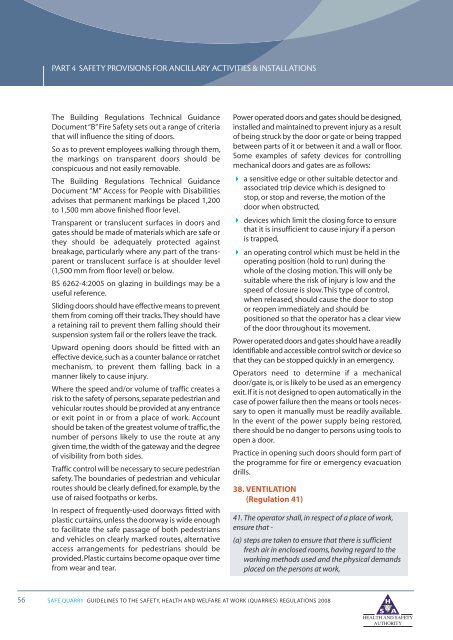Safe Quarry - Health and Safety Authority
Safe Quarry - Health and Safety Authority
Safe Quarry - Health and Safety Authority
You also want an ePaper? Increase the reach of your titles
YUMPU automatically turns print PDFs into web optimized ePapers that Google loves.
PART 4 SAFETY PROVISIONS FOR ANCILLARY ACTIVITIES & INSTALLATIONS<br />
The Building Regulations Technical Guidance<br />
Document“B”Fire <strong>Safe</strong>ty sets out a range of criteria<br />
that will influence the siting of doors.<br />
So as to prevent employees walking through them,<br />
the markings on transparent doors should be<br />
conspicuous <strong>and</strong> not easily removable.<br />
The Building Regulations Technical Guidance<br />
Document “M” Access for People with Disabilities<br />
advises that permanent markings be placed 1,200<br />
to 1,500 mm above finished floor level.<br />
Transparent or translucent surfaces in doors <strong>and</strong><br />
gates should be made of materials which are safe or<br />
they should be adequately protected against<br />
breakage, particularly where any part of the transparent<br />
or translucent surface is at shoulder level<br />
(1,500 mm from floor level) or below.<br />
BS 6262-4:2005 on glazing in buildings may be a<br />
useful reference.<br />
Sliding doors should have effective means to prevent<br />
them from coming off their tracks.They should have<br />
a retaining rail to prevent them falling should their<br />
suspension system fail or the rollers leave the track.<br />
Upward opening doors should be fitted with an<br />
effective device,such as a counter balance or ratchet<br />
mechanism, to prevent them falling back in a<br />
manner likely to cause injury.<br />
Where the speed <strong>and</strong>/or volume of traffic creates a<br />
risk to the safety of persons,separate pedestrian <strong>and</strong><br />
vehicular routes should be provided at any entrance<br />
or exit point in or from a place of work. Account<br />
should be taken of the greatest volume of traffic,the<br />
number of persons likely to use the route at any<br />
given time,the width of the gateway <strong>and</strong> the degree<br />
of visibility from both sides.<br />
Traffic control will be necessary to secure pedestrian<br />
safety. The boundaries of pedestrian <strong>and</strong> vehicular<br />
routes should be clearly defined,for example, by the<br />
use of raised footpaths or kerbs.<br />
In respect of frequently-used doorways fitted with<br />
plastic curtains, unless the doorway is wide enough<br />
to facilitate the safe passage of both pedestrians<br />
<strong>and</strong> vehicles on clearly marked routes, alternative<br />
access arrangements for pedestrians should be<br />
provided.Plastic curtains become opaque over time<br />
from wear <strong>and</strong> tear.<br />
Power operated doors <strong>and</strong> gates should be designed,<br />
installed <strong>and</strong> maintained to prevent injury as a result<br />
of being struck by the door or gate or being trapped<br />
between parts of it or between it <strong>and</strong> a wall or floor.<br />
Some examples of safety devices for controlling<br />
mechanical doors <strong>and</strong> gates are as follows:<br />
a sensitive edge or other suitable detector <strong>and</strong><br />
associated trip device which is designed to<br />
stop, or stop <strong>and</strong> reverse, the motion of the<br />
door when obstructed,<br />
devices which limit the closing force to ensure<br />
that it is insufficient to cause injury if a person<br />
is trapped,<br />
an operating control which must be held in the<br />
operating position (hold to run) during the<br />
whole of the closing motion.This will only be<br />
suitable where the risk of injury is low <strong>and</strong> the<br />
speed of closure is slow.This type of control,<br />
when released, should cause the door to stop<br />
or reopen immediately <strong>and</strong> should be<br />
positioned so that the operator has a clear view<br />
of the door throughout its movement.<br />
Power operated doors <strong>and</strong> gates should have a readily<br />
identifiable <strong>and</strong> accessible control switch or device so<br />
that they can be stopped quickly in an emergency.<br />
Operators need to determine if a mechanical<br />
door/gate is, or is likely to be used as an emergency<br />
exit.If it is not designed to open automatically in the<br />
case of power failure then the means or tools necessary<br />
to open it manually must be readily available.<br />
In the event of the power supply being restored,<br />
there should be no danger to persons using tools to<br />
open a door.<br />
Practice in opening such doors should form part of<br />
the programme for fire or emergency evacuation<br />
drills.<br />
38. VENTILATION<br />
(Regulation 41)<br />
41. The operator shall, in respect of a place of work,<br />
ensure that -<br />
(a) steps are taken to ensure that there is sufficient<br />
fresh air in enclosed rooms, having regard to the<br />
working methods used <strong>and</strong> the physical dem<strong>and</strong>s<br />
placed on the persons at work,<br />
56<br />
SAFE QUARRY GUIDELINES TO THE SAFETY, HEALTH AND WELFARE AT WORK (QUARRIES) REGULATIONS 2008
















